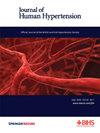The hidden role of left atrial strain: insights into end-organ damage in dipper and nondipper hypertension
IF 3.4
4区 医学
Q2 PERIPHERAL VASCULAR DISEASE
引用次数: 0
Abstract
Hypertension is a major global health concern associated with significant morbidity and mortality due to its effects on target organs such as the heart, kidneys, and brain. Non-dipper hypertension, characterized by insufficient nocturnal blood pressure reduction leading to sustained hemodynamic load, is linked to higher risks of end-organ damage. This study evaluates the impact of hypertension on LA anatomy and physiomechanics and explores the association of LA strain parameters with hypertensive heart disease and nephropathy. This prospective, single-center cohort study included 135 participants: 35 healthy controls, 50 dipper hypertension, and 50 non-dipper hypertension patients. All participants underwent 24-h ABPM, biochemical analysis, and transthoracic echocardiography, including speckle-tracking echocardiography, a novel technique for LA strain analysis. LA diameter,LASr, and LAVI maximum were identified as significant parameters associated with hypertensive end-organ damage. Non-dipper hypertension was associated with significantly higher 24-h blood pressure values and reduced nocturnal dipping compared to dipper hypertension. LA strain parameters(LASr, LAScd, LASct) were significantly lower in the non-dipper group. These reductions indicate impaired left atrial mechanics and early cardiac dysfunction. Logistic regression revealed that LA diameter, LASr, and LAVI maximum were significant variables associated with hypertensive heart disease, whereas only LASr was significantly associated with hypertensive nephropathy. LA strain analysis provides valuable insights into the pathophysiology of hypertension and its complications. The findings support the use of LA parameters as cost-effective, noninvasive biomarkers for assessing associations with hypertensive heart disease and nephropathy, enabling early risk stratification. This emphasizes the importance of enhanced monitoring and tailored interventions for high-risk patients.

左心房劳损的隐藏作用:对斗和非斗高血压终末器官损害的认识。
高血压是一个主要的全球健康问题,由于其对靶器官如心脏、肾脏和大脑的影响,与显著的发病率和死亡率相关。以夜间血压降低不足导致持续血流动力学负荷为特征的非低血压高血压与终末器官损伤的高风险有关。本研究评估高血压对左心室解剖和生理力学的影响,探讨左心室应变参数与高血压心脏病和肾病的关系。这项前瞻性、单中心队列研究包括135名参与者:35名健康对照者,50名北斗高血压患者和50名非北斗高血压患者。所有参与者进行了24小时ABPM,生化分析和经胸超声心动图,包括斑点跟踪超声心动图,这是一种用于LA应变分析的新技术。lai直径、LASr和LAVI最大值被认为是与高血压终末器官损伤相关的重要参数。与北斗高血压相比,非北斗高血压与24小时血压值显著升高和夜间血压下降有关。非倾角组LA应变参数(LASr、LAScd、LASct)显著降低。这些减少表明左心房力学受损和早期心功能障碍。Logistic回归分析显示,lar直径、LASr和LAVI最大值是与高血压心脏病相关的显著变量,而只有LASr与高血压肾病相关。LA应变分析为高血压及其并发症的病理生理学提供了有价值的见解。研究结果支持将LA参数作为具有成本效益的无创生物标志物,用于评估高血压心脏病和肾病的相关性,从而实现早期风险分层。这强调了加强对高危患者的监测和针对性干预的重要性。
本文章由计算机程序翻译,如有差异,请以英文原文为准。
求助全文
约1分钟内获得全文
求助全文
来源期刊

Journal of Human Hypertension
医学-外周血管病
CiteScore
5.20
自引率
3.70%
发文量
126
审稿时长
6-12 weeks
期刊介绍:
Journal of Human Hypertension is published monthly and is of interest to health care professionals who deal with hypertension (specialists, internists, primary care physicians) and public health workers. We believe that our patients benefit from robust scientific data that are based on well conducted clinical trials. We also believe that basic sciences are the foundations on which we build our knowledge of clinical conditions and their management. Towards this end, although we are primarily a clinical based journal, we also welcome suitable basic sciences studies that promote our understanding of human hypertension.
The journal aims to perform the dual role of increasing knowledge in the field of high blood pressure as well as improving the standard of care of patients. The editors will consider for publication all suitable papers dealing directly or indirectly with clinical aspects of hypertension, including but not limited to epidemiology, pathophysiology, therapeutics and basic sciences involving human subjects or tissues. We also consider papers from all specialties such as ophthalmology, cardiology, nephrology, obstetrics and stroke medicine that deal with the various aspects of hypertension and its complications.
 求助内容:
求助内容: 应助结果提醒方式:
应助结果提醒方式:


